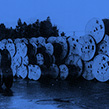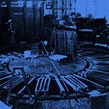Continuous copper casting and rolling machine, Fuji Factory (2014)
Episodes in Yazaki’s development and business growth
This section presents episodes describing Yazaki product development,
through which our predecessors brought wire harnesses and many other flagship products to the world.
HOME Episodes in Yazaki’s development and business growth A drum business that conserves valuable wood resources and recycles waste plastic

Drum recycling
A drum business that conserves valuable wood resources and recycles waste plastic

Recycling of wooden electric wire drums
“The wood used to make electric wire drums is an important natural resource,” said Yazaki’s founder, Sadami Yazaki. In the interest of helping protect the environment, I want us to do all we can to recycle it.” With this one statement, Yazaki’s drum recycling business was set in motion.
The drums upon which electric wires were wound for transport were made of wood, and they were typically discarded at the worksite following product delivery. They ranged in size from 43 cm in diameter, small enough for even a child to carry, to 2 m 60 cm in diameter, or much higher than a man’s height. Discarding them as is amounted to a tremendous waste. Thus, the recycling of drums—i.e., their recovery, mending, and reuse—was highly significant in terms of conservation of global wood resources. Yazaki began recycling drums in 1971. Ten years later, in 1981, it established Yawara Kogyo (currently Yawara Industries) as a specialized recycling company, and began full-scale recycling operations. For a while, the number of drums unable to withstand mending increased, which kept the recycling rate down at around 60%. However, it later rose to above 80%, where it remains today. The number of times drums are reused has also risen to an average of five or six times. Thus, recycling is making a major contribution to the conservation of wood resources.
Reusing troublesome waste plastic in drums
On the other hand, there is also the troublesome problem of plastic waste that does not biodegrade even if buried in the soil. Would it be possible to reuse and recycle this plastic waste to make drums?
In 1972, Yazaki began developing electric wire drums out of plastic waste. And in the spring of 1973, it began taking steps toward making “waste plastic drums” commercially viable. After prototypes passed strength tests and cold area durability tests, Yazaki began full-scale production, beginning with drums of one meter in diameter or larger that are highly effective in the effort to substitute wood resources.

Results that attracted great interest from a US-European team
Yazaki continued replacing its wooden electric wire drums with waste plastic drums. Of course, this did not escape the attention of Western developed countries, where resource utilization and recycling have long been a concern.
The Finnish Embassy in Japan was the first to ask about the drums, having received an order to do so from its government. It was followed by a torrent of inquires from electric wire companies and drum manufacturers in then West Germany, the United States, Italy, France and other countries All of those inquiring had conducted research on drums; however, they were using virgin plastic or had encountered poor cost performance or other problems. In March of 1975, an observation team consisting of thirty-six members from eight European countries toured Fuji Factory. The tour became a boisterous affair, with a flurry of questions in English, German, and French flustering even Yazaki guides known for their international experience. It was an episode in which Yazaki’s characteristic forward-looking stance was on full display.
EPISODE SELECTION
EPISODE 01 Aroace: Overcoming obstacles buoyed on the founder’s adventurous spirit
EPISODE 02 The egg lays the chicken: The secret story behind the birth of the wire harness
EPISODE 03 A drum business that conserves valuable wood resources and recycles waste plastic
EPISODE 04 “LP10”: The gas meter that changed how people think about propane
EPISODE 05 Moving toward a sustainable future as a pioneer in the use of solar heat
EPISODE 07 From the quagmire of labor dispute rose the grand flower of the meter
EPISODE SELECTION















